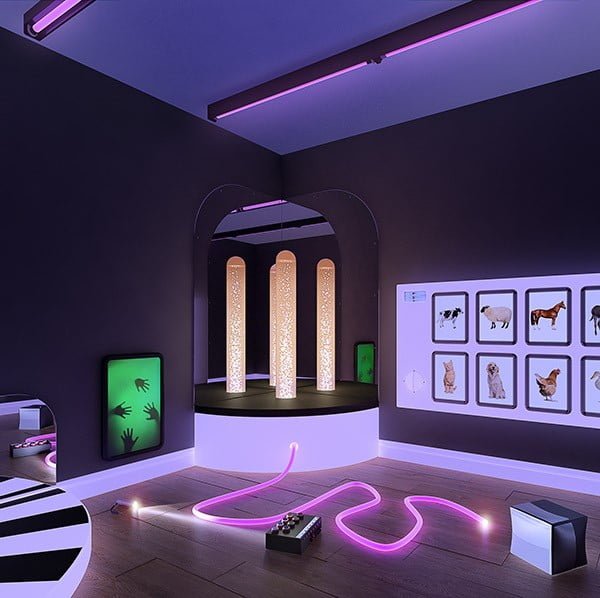Does your child struggle with Sensory Processing Disorder?
For children with special needs, navigating the world around them can often be overwhelming. Everyday stimuli like lights, sounds, and textures can trigger anxiety, stress, or sensory overload.
This is where sensory rooms come into play, offering a safe and therapeutic environment designed to stimulate the senses and promote relaxation and well-being.
In this article, we’ll explore what sensory rooms are, why they’re invaluable for children with special needs, and the myriad benefits they offer.
What is a Sensory Room?
A sensory room, also known as a multisensory environment or sensory integration room, is a specially designed space equipped with a variety of sensory equipment and materials.
These rooms are intentionally created to engage and stimulate the senses—sight, sound, touch, smell, and sometimes even taste—in a controlled and therapeutic manner.
Each sensory room is unique, tailored to meet the specific needs and preferences of the individuals who will be using it.
Why Sensory Rooms Are Great for Children with Special Needs:
Sensory Stimulation and Exploration: Sensory rooms provide a safe and supportive environment for children to explore and engage with various sensory stimuli. From vibrant lights and soothing sounds to tactile surfaces and calming scents, these experiences encourage sensory exploration and help children develop their sensory processing skills.
Calming and Regulation: For children with sensory processing disorders, sensory rooms offer a sanctuary where they can find relief from overwhelming sensory inputs. Through specialized equipment such as weighted blankets, rocking chairs, and sensory swings, children can regulate their sensory responses and achieve a state of calm and relaxation.
Promotion of Sensory Integration: Sensory integration is the ability to organize and interpret sensory information from the environment effectively. Sensory rooms provide opportunities for children to engage in activities that promote sensory integration, helping them develop greater body awareness, coordination, and motor skills.
Emotional Expression and Communication: Sensory experiences can serve as powerful tools for emotional expression and communication. In a sensory room, children are encouraged to express themselves through play, movement, and interaction with sensory materials. This facilitates nonverbal communication and allows children to communicate their needs and feelings in a supportive and nonjudgmental space.
Enhanced Focus and Attention: Many children with special needs struggle with attention and focus due to sensory distractions or challenges. Sensory rooms offer activities and equipment designed to promote concentration and engagement, such as interactive light displays, calming music, and tactile surfaces. By providing a sensory-rich environment, these rooms help children improve their ability to attend to tasks and activities.
Social Interaction and Play: Sensory rooms can also serve as social hubs where children can interact with peers and caregivers in a comfortable and inclusive setting. Through cooperative play, turn-taking, and shared sensory experiences, children develop important social skills such as cooperation, empathy, and communication.
Sensory Diet Planning: Sensory rooms play a crucial role in implementing sensory diets—a personalized schedule of sensory activities designed to meet an individual’s sensory needs and preferences. Occupational therapists and special educators can use sensory rooms to assess a child’s sensory profile and develop tailored intervention plans to support their sensory development and emotional well-being.
What is Sensory Processing Disorder?
Sensory Processing Disorder is a condition in which the brain has trouble receiving and responding to information that comes in through the senses and may look like one of the following below.
Here are some other signs you might see in your child:
- Overwhelmed by people and places
- Seeks out quiet spots in noisy, crowded environments such as Parks and Stores
- Easily startled by sudden noises
- Bothered by bright lights
- Refuses to wear certain clothing
- Avoids touching people
- Texture of items and feelings of things
- Has a strong reaction to the texture or smell of certain foods
- Refuses to try new foods and has a very limited diet of preferred foods
- Gets upset about small changes in routine or environment
Lighting
In my classroom at school I have some students who are highly sensitive to bright lights in the classroom. By changing the lighting of the environment this adds a sense of calmness and soothing space for children to thrive at school and home.
Swings
Utilizing Swings in the classroom or any therapeutic setting is a great way to get your child with special needs to calm down. Swings provide the perfect way to calm any child who has had a mental breakdown.
Sitting
Maintaining posture and seating in one place for a very long period of time for a child with a disability can be very frustrating. Finding the best seating for your child that struggles with sensory disorders doesn’t have to be a daunting experience when getting your child to sit for a long period of time at home.
Home Gym/Movement
Children with sensory processing disorders require a lot of movement and routines just as much as any other child. Having a home gym for your child can be a great way to keep their minds active, and to also create safe space for them that is free of noises.
Bouncy Balls
Bouncy balls have been a great way to help calm students in my classroom when it comes to calming them down from situations such as a change in routine or just needs a stimulating feel of learning inside the classroom. These bouncy balls are great for children learning from home as well as inside the classrooms.
Sensory Sand/Water Table
Including a sand or water table into your child’s daily life can be a great advantage. The texture and feeling of the sand and water is so soothing not only to us adults when we’re at the beach but also to children. I always made sure to include this station during my preschool teaching days.

Sensory Tent
When teaching the Emotional Behavioral self-contained classroom and having a sensory tent inside my classroom saved on a lot of meltdown in my classroom. In the tent the students could listen to music, draw, or squeeze a ball to calm down.
Trampoline (Movement)
Trampolines have been around for many years and have been the joy for parents to keep their child occupied for numerous hours. Trampolines are a great way to keep your child stimulated and to build gross motor skills while staying in motion in one place.
Fidget Boxes
Fidget boxes are a great way to build fine and grow motor skills when used appropriately. These boxes helps children to not only calm them down but also builds confidence when in uncomfortable situations when it requires them to use their calming techniques in tough situations when becoming frustrated.
Conclusion
Overall, each sensory item or method may not work for your child and that’s okay. You just need to pick and choose what works best for your child.
Comment down below what you have in your sensory room or what you plan to add in the near future.















